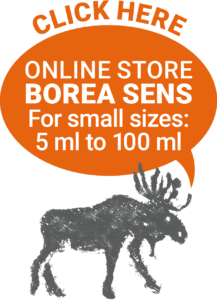LABRADOR TEA ESSENTIAL OIL

Latin Name: Rhododendron groenlandicum or Ledum groenlandicum
French Name: Thé du Labrador, Lédon du Groenland
English Name: Labrador Tea, Greenland Moss
Botanical Family: Ericaceae
Origin: Quebec, Canada
Harvest time: July to August
Distilled Parts: Leaves
Organoleptic Specificities: Light-yellow liquid with a resinous, herbaceous and pollen smell in base notes.
Components: Sabinene, α et β-selinene, α et β-pinene, Terpinen-4-ol, γ-terpinene, bornyl acetate
ORIGIN
The Greenland Moss is a medium-sized shrub found in North America from coast to coast: it crosses the Rockies to the West Coast, extends out from Alaska to the tundra of the lower Arctic mainland. Labrador tea is found on peaty, acidic and swampy soils. It will choose the least humid places such as mounds and woodlands or semi-wooded areas. It is often found in the presence of the black spruce. This resinous shrub with thick alternating and persistent leaves, gives white flowers grouped like an umbrella and which are overtaken by young shoots in the spring. The back of the leaf of the Labrador Tea plant is particular, because of the presence of woolly hairs that are white or orange.
HISTORY
The Greenland Moss is a wild tea well-known to explorers, First Nations, Inuit and Americans of the time. When tea was in short supply, Labrador tea was a common substitute. Crees from Hudson Bay used it for healing by chewing the leaves and applying it to wounds. Native American women take an infusion three times a day to facilitate delivery. Powdered leaves are very effective against headache thanks to its analgesic power. This powder mixed with fish oil was also applied directly on a baby’s irritated skin. Labrador tea is one of the most therapeutic herbs used by native North Americans.
BENEFITS
Labrador tea increases energy metabolism and stimulates the body. It is very well known for its activity in the liver and for managing major moments of intense stress.
Physical
- Circulatory system: lymphotonic, venous and lymphatic decongestant.
- Skin system: very high affinity for skin and mucous membranes, tones, softens and regenerates tissues. Inflammatory, purifying and soothing.
- Digestive system: digestive, eupeptic, stomach, hepatic stimulant, appetite inducing, spasmolytic of knotted intestinal solar plexus with analgesic properties, mucolytic and lipolytic effect. Stimulates the pancreas.
- Endocrine system: cortisone-like (corticotropic axis), harmonizes hormonal balance.
- Immune system: antibacterial, antiseptic, antiviral, antifungal, immunostimulant.
- Nervous system: sedative, harmonizes and calms the nervous system at the neurotransmitter level, anxiolytic.
PSYCHIC
- Psycho toning.
- Increases concentration ability.
- Brings calm and serenity.
Uses: Circulatory hepatic intoxication, viral enteritis, flatulence, toxemic or microbial nephritis, infectious prostatitis and prostatic congestion, lymphangitis, inflammation of the ganglia, insomnia, nervousness, plexus spasms, allergies and hypersensitivity of the skin.
Contra-indications: To avoid during the first 6 months of pregnancy, by children under 6 years of age and epileptics.
Recommendation: Essential oils are wonderful for the well-being of humans, animals, insects and plants. There are many books on aromatherapy, which should be referred to for proper and safe use.
It is recommended to store essential oils in a cool, dry place, protected from light and air.
The information provided on this website is NOT a recommendation of a cure or the treatment of a medical condition or disease.
References
- Franchomme, P., Jollois, R,. Pénoël, D., L’aromathérapie exactement, Encyclopédie de l’utilisation thérapeutique des huiles essentielles, fondements, démonstration, illustration et applications d’une science médicale naturelle, Bayeux, Éditions Roger Jollois, 2001. Hydrosols : The Next Aromatherapy, 2001.
- Miles E., Baudoux D., Les cahiers pratiques d’aromathérapie selon l’École Française, volume 6, Réflexologie, Belgique, Édition Inspir S.A., 2008.
- Festy, Danièle, Ma Bible des huiles essentielles, Guide complet d’aromathérapie, Canada, Éditions Caractère, 2009.
- Site officiel : Ressources naturelles Canada
- © Springer Science+Business Media Dordrecht 2015
- Traditional use of medicinal plants in the boreal forest of Canada: review and perspectives: ncbi.nlm.nih.gov
- Plantes sauvages des lacs, rivières et tourbières, Guide d’identification Fleurbec, Saint-Augustin (Portneuf), Québec, Fleubec Éditeur, 1987.
- « Le thé du Labrador : un thé antidouleur | Marie-France Léger | Santé », La Presse, 13 août 2013 (lire en ligne [archive])
- Moerman Daniel E., Native American Ethnobotany, Timber Press, Portland, Oregon, 1998.

